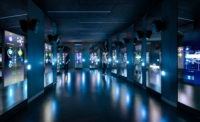When Sotheby’s unveiled its revamped New York headquarters earlier this month, the art installations within the new galleries rivaled any in the venerated museums—the Met, Met Breuer, Frick, Guggenheim—within walking distance of it on Manhattan’s Upper East Side. But the 275-year-old auction house isn’t competing with those neighboring institutions. “The art market is changing so rapidly and substantially,” says Allan Schwartzman, Sotheby’s executive vice president and chairman of the fine-art division. “We envision programming well beyond the historical core of our business.”
Sotheby’s had been considering leaving its home of nearly 20 years, a 10-story building that covers an entire city block, for a move to Midtown. Says Schwartzman, “There were fundamental limitations to displaying art in, and moving through, our building,”—a four-story former factory onto which six stories were added in a 2001 project by KPF. Sotheby’s engaged several architects to develop designs for a new space it had selected, but also to reimagine its existing building—in order to convince the board that a move was necessary.
Ironically, the scheme by OMA NY partner Shohei Shigematsu convinced them otherwise. “There are columns every 20 feet on the lower levels,” Schwartzman explains. “But Shohei found a way to embed columns in walls, or, when visible, to become a prominent feature of the architecture.”
“Brands reach out to architects when they are rethinking their brand,” says Shigematsu. “So it’s about much more than the architecture.” Here, though, in OMA’s first major gallery space in the U.S., the architectural moves—in some cases drastic, like slicing through floor slabs to create double-height galleries, in others subtle, such as lining the thresholds into gallery clusters with custom-stained walnut panels in a nod to Sotheby’s London—offer the auction house ideal ways to show art and luxury goods in isolation and in broader combination. All galleries were moved to the lower four levels, increasing exhibition space from 67,000 to over 90,000 square feet. The new configuration is more welcoming to the public and eliminates the bottleneck of traffic to what had been its premiere exhibition space on the 10th floor, which will be converted to offices. “There’s no hierarchy now,” notes Schwartzman. The $55 million project includes 40 new galleries of 20 distinct types—from white cube to enfilade, octagonal, and L-shaped—that range in size and materials to respond to different sales, exhibitions, and events, and allow the auction house to easily and frequently change out shows without disrupting other galleries or building temporary walls. “Flexibility is provided through diversity,” says Shigematsu.
Adds Schwartzman, “Having these redesigned galleries positions us to be able to grow the business in ways that we don’t even know about, but that will be needs of the near and further future.” In the meantime, the new space served as the perfect backdrop for Monday night's record-breaking sales, which included the $110.7 million sale of Meules (1890)—the highest sum ever paid for a work by Claude Monet, or any Impressionist work of art.














